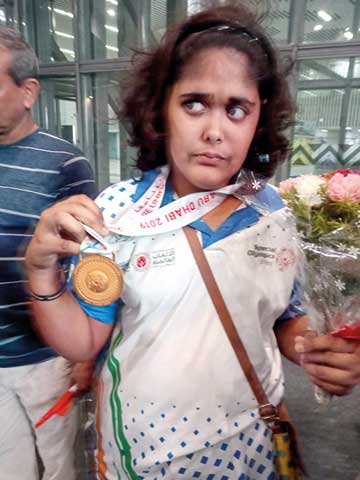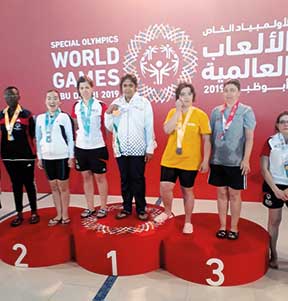Sourina Bose
If you have already read the reports doing the rounds on all sports pages of national dailies, you must be expecting what I am going to discuss next – yes, the recently concluded Special Olympics World Games 2019 at Abu Dhabi where Indian athletes performed remarkably well. India won a total 368 medals at the Olympics, out of which the ‘special sportspersons’ have won 85 gold medals. Now this would not have been possible if these special children had not undergone formal training, regular practices and a rigorous routine in maintaining their bodies. And of course, what made all these things possible was physical education.
Every one of us requires physical exercises and what better than asking children to do what they love the most – play games, designed as physical education in the school curriculum. We have a mindset that PE is essentially for those who are independent physically or mentally. At the same time, we have to realize that of all the specially designed instructions, which are set to meet the unique needs of a child with a disability, including those given in the classroom and instructions in physical education, the latter has been more effective in imparting lessons to these special children. They develop fundamental motor skills and patterns, skills in aquatics, dance and individual and group games and sports through physical education.
“They are different, they do not understand the cause and effect equation,” quipped Lina Bardhan, former Director, Special Olympics Games, West Bengal and principal, Noble Mission School, Kolkata. Bardhan remembered an incident of the early 90s when she had taken Soumyo, a special child, in the athlete arena and asked him to participate for the 100-metre race. Very reluctant to run, he did so after a lot of coaxing but stopped midway refusing to complete the race. Bardhan, who was his teacher then ran alongside him to help him finish the race. Soumyo won his first gold medal and thereafter he never stopped halfway.
 Each child is born different and with varied special needs. For each and every need, there are therapies and surprisingly all these activities have interesting names. Swimming, for instance is known as ‘hydrotherapy’. Parimal Bera, Lecturer in Special Education, National Institute for Empowerment of Persons with Intellectual Disabilities, Kolkata, said, “Children find these therapies interesting because they not only improve their inability to perform something but also add recreational value in learning. Music therapy is amazing with songs and dance teamed with a lot of entertainment.” This method of treatment has become popular giving rise to therapists across the globe practising occupational therapy, equine therapy, speech therapy and many more.
Each child is born different and with varied special needs. For each and every need, there are therapies and surprisingly all these activities have interesting names. Swimming, for instance is known as ‘hydrotherapy’. Parimal Bera, Lecturer in Special Education, National Institute for Empowerment of Persons with Intellectual Disabilities, Kolkata, said, “Children find these therapies interesting because they not only improve their inability to perform something but also add recreational value in learning. Music therapy is amazing with songs and dance teamed with a lot of entertainment.” This method of treatment has become popular giving rise to therapists across the globe practising occupational therapy, equine therapy, speech therapy and many more.
Sharmistha Basu, Special Educator, Noble Mission School, Kolkata highlighted that PE is a must for children with special needs because it improves their body co-ordination and helps them develop motor skills. Basu who has been in this profession for more than two decades now strongly feels that “regular exposure to physical education helps these children develop emotional and social behaviours.” I spent a lot of time speaking with Soma Pal Roy, Special Educator, Lakshmipat Singhania Academy, Kolkata in the course of working on this article. Often, I have seen children walking up to her chamber and expressing their inability to understand some theoretical subject. Roy always enquired if they had attended their PE classes or not. She told me, “Children who have a diagnosed intellectual disability may have additional physical disabilities which can result in below age-level performance in typical motor skills. However, with regular involvement in physical education and sport they can improve and develop the skills they need. When encouraged to participate in frequent fitness measures, many students with special needs see improvements in everything from their hand-eye coordination and flexibility, to their muscle strength, endurance, and even cardiovascular efficiency.”
Physical education is important in everyone’s life. It not only improves your fitness level but strengthens your mind as well. It has been found that any kind of physical activity improves general mood and wellness in psychiatric patients suffering from anxiety and depressive disorders. Regular exercises link to improvements in self-esteem, social awareness, and self-confidence which are all essential for empowering the lives of young people with special needs. Providing a physical outlet may help students reduce or cope with anxiety, stress and depression while interaction and involvement with other students will help foster a sense of accomplishment and confidence. For students with special needs, developing a sense of self-esteem can be particularly important, as they may often feel isolated and removed from the group. This is where PE works wonders by involving them in environments where they can feel as though they’re successfully contributing to a group, and their abilities in other areas will improve according to their positive self-image and confidence.
Psychiatrists feel that physical education leads to cognitive improvements in children with special needs, allowing them to access skills that they did not know they had within a traditional classroom setting. Classroom- based learning and the structure of sport is completely different. Sport comes with a set of rules and organization that can be a learning tool that helps children to practice self-regulation and enhance their decision-making skills. Moreover, children with special needs can learn to focus on specific goals, and work on their verbal communication by interacting with peers through sport. Physical education is about a lot more than simply learning how to engage in a particular sport. It teaches children a range of skills from how to work as a team, or how to solve problems, increase attention span, and focus on task-based behaviour. Eventually, those skills can transfer into other classroom settings too, so that students with special needs have a greater ability to learn and engage with their peers outside of physical education.
While talking to Madam Bardhan, I understood that there is no elimination at the elementary level while selecting children for Special Olympics. She rightly said, “Why will we send them back when we have encouraged them to take their first step towards sports?” My next question was then how do you manage such a huge contingent of sportspersons if no one is eliminated? She explained beautifully with this example – “Imagine there are 50 participants for a 100 metres race. Out of that, let’s say, 10 will be amazing runners while the others might have an increased time record. In that case, we will pair the first 10 in one group, the next in the second one and so on and so forth.” Here, the biggest advantage is these children are grouped alongside their peers both in physical and mental ability. Gradually after zonal selections, they move to the national level where camps are arranged and the selected bunch undergoes rigorous training till a fine capable and strong team is prepared. So, the elimination here takes a long time to happen and more importantly, everyone gets a fair chance to perform.
 These interactions were illuminating as not many of us get to speak to gold medal winners every day. Yes, I spoke to 18-year-old Salmoli Chakraborty who is a huge Hrithik Roshan and Virat Kohli fan. Chakraborty recently won a gold and a bronze medal in swimming at the Special Olympics World Games 2019 in Abu Dhabi – the gold in the 25-metre breast stroke and bronze for the backstroke. Chakraborty had been diagnosed with learning disabilities when she was in class two. But that has not deterred her from taking up swimming as a challenge. She is in the eighth standard now and completing her studies through the Open School system. The last two years were very hard for Salmoli as she was training in several parts of India. But all her sweat paid off as she made her parents and country proud. People like Salmoli inspire many of us to overcome hurdles and walk forward always in life.
These interactions were illuminating as not many of us get to speak to gold medal winners every day. Yes, I spoke to 18-year-old Salmoli Chakraborty who is a huge Hrithik Roshan and Virat Kohli fan. Chakraborty recently won a gold and a bronze medal in swimming at the Special Olympics World Games 2019 in Abu Dhabi – the gold in the 25-metre breast stroke and bronze for the backstroke. Chakraborty had been diagnosed with learning disabilities when she was in class two. But that has not deterred her from taking up swimming as a challenge. She is in the eighth standard now and completing her studies through the Open School system. The last two years were very hard for Salmoli as she was training in several parts of India. But all her sweat paid off as she made her parents and country proud. People like Salmoli inspire many of us to overcome hurdles and walk forward always in life.
Salmoli’s story is a perfect example to help realize that physical education can enhance academic performance and cognitive function. However, for children with special needs, it is valuable for so many reasons from providing an opportunity to build collaborative and social skills to teaching them how to focus on specific goals and overcome obstacles. Parents and teachers are encouraged to find creative ways to implement reasonable accommodations to ensure that all students with special needs can be successful in physical education and in elementary academics. Meanwhile, we can all sit back and imbibe what Javed Akhtar has beautifully penned down –
“Yeh To Asha Ki Leher Hai
Yeh To Umeed Ki Seher Hai, Khushiyon Ki Nehar Hai
Kho Na Jaaye Yeh Taare Zameen Par…”
The author is Assistant Secretary of Bichitra Pathshala and a teacher of Mass Media Studies at Lakshmipat Singhania Academy, Kolkata. She can be reached at sourinabose@gmail.com.
